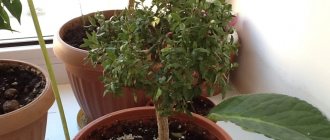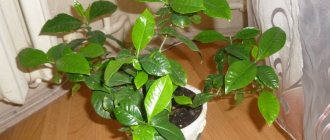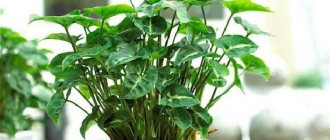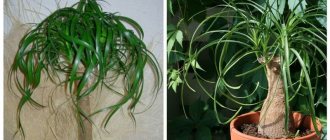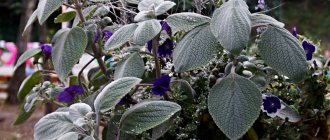The adenium plant is a member of the Kutrov family. This genus contains 5 species. This succulent is found naturally in Central and Southern Africa. In indoor conditions, such small trees or shrubs reach a height of about 0.35 m. The trunk of this flower is thick. The surface of the glossy sheet plates is velvety. Quite large flowers are painted white or dark crimson. Popularly, this plant has many other names, the most popular being “Desert Rose”, because this flower is similar to a rose.
Types and varieties of adenium: photos and descriptions of some varieties
The plant belongs to the Arosupaceae (Kutrovaceae) family.
There are about 50 different varieties of adenium, with some differences in the appearance and overall development of the plant. However, not all types of adenium are used for domestic cultivation, and most of them remain exclusively wild plants. Below is a description of some of them.
Adenium crispum
This plant can be distinguished by its very unusual oblong and very narrow leaves. Each leaf of this species has a wavy surface, especially noticeable at the edges of the leaf body. The stem thickening is mostly located underground, which is also not entirely common for representatives of this genus.
The photo shows that this type of adenium has very original inflorescences, the base of which is painted yellow-white, and the edges of the petals are a very rich crimson color:
In the center of each petal you can see several longitudinal stripes of the same color as the outer part of the flower.
Adenium multiflora or multiflorum
Among the varieties of adenium, this one is distinguished by its shape, which is more akin to a shrub than to a tree-like plant. This feature is due to the large number of thin, very highly branched shoots.
This species begins to bloom at the beginning of winter and is distinguished by a large number of inflorescences. Each flower has a diameter of about 5 - 7 cm. The border of the petals is painted in a very bright dark crimson color, the base is white.
Adenium obesum or obese
This species differs in many ways from most of its other brethren. The base of the trunk of this species is about 1 m wide, and is much thicker than the two previous trees.
Branching begins at the very top of the trunk. The leaves are leathery, gray-green in color and quite sparsely scattered throughout the crown. The length of each individual leaf is usually no more than 10 cm.
In total, this species reaches approximately 1.5 m in height. This plant blooms preferably in summer. The inflorescences are small, each individual flower reaches 4–6 cm in diameter.
Adenium Mini Size
As you can see from the photo, this variety of adenium is ideally suited for growing indoors - its height is only 12 - 17 cm.
Adenium arabic
A feature of this species is the ability to grow up to 4 m in height. The species is also distinguished by the largest leaves in the genus - sometimes they reach up to 20 cm in length and 12 cm in width. True, this happens in the case of ideal climatic conditions. In a less favorable environment, this species becomes a low shrub plant.
Most of its thickened base goes almost completely underground, and the branching begins quite low. Arabic adenium blooms in early spring, after awakening from hibernation. However, individual flowers may appear sporadically throughout the year. The color of the flowers is bright pink.
Adenium swazicum
Another type of shrub-like adenium. The photo shows that the home adenium flower is no more than 30 cm tall, but taller specimens are also bred through selection (up to 65 cm):
From the thickening of this plant several branches grow, forming a wide crown at their ends. The stems may hang over the pot as they usually grow somewhat horizontally.
The tree does not hibernate and, with proper care, remains evergreen. The flowers do not have the color transitions characteristic of adenium and are completely colored in one tone (usually light pink).
The tree is native to countries such as South Arabia, Uganda, Kenya, and Tanzania. In its homeland, when developing in a tree’s natural environment, it can reach 3 m in height. At the same time, when caring for adenium at home, it will not be possible to obtain a height greater than 50–60 cm, since it is very difficult to bring the plant’s living conditions closer to natural ones.
How to stimulate adenium flowering: location and temperature
Growing and caring for adenium at home is not a very painstaking task, but still requires some attention, since this plant is not accustomed to being in temperate latitudes. In order for a flower to grow and develop properly, it is important to take into account factors such as the location of the plant, watering and fertilization, temperature and many others.
It is important to remember that caring for an adenium flower at home requires some care, since the natural development environment of this plant is quite specific. It is better to choose a warm place for the tree, with bright sunlight. In winter, perhaps a less bright place.
In summer you can put it outdoors, in a sunny, wind-protected place. Interestingly, what kind of lighting the plant needs directly depends on the air temperature in the room where the flower grows. The warmer the room, the more light the tree needs, and vice versa.
The optimal lighting time for adenium is 12 hours. This is especially true for those times of year when the heating is turned on in the house and because of this the plant requires a lot of light. For this reason, artificial lighting may be required in winter.
However, this also has its own characteristics - the daylight hours for this flower should not exceed 14 hours. It is also worth keeping an eye on this in the summer, when the daylight hours are 16 hours long. In this case, at the end of the day, it is better to take the pot of adenium into a darker room.
Using the above knowledge, you can stimulate the flowering of adenium, since it directly depends on the habitat of the tree. Typically, most varieties begin to bloom with maximum light and a warm room.
A positive feature of a plant such as adenium is that, with proper watering, it is quite unpretentious to the temperature it stays in. In its native subtropical and tropical climate, the plant can easily tolerate temperatures of 42°C and above, which is due to sufficient air humidity.
However, in such conditions, the inflorescences wither much faster. In summer, the optimal temperature for adenium fluctuates around 30-35°C in combination with moderate humidity.
At temperatures above 38°C and below 16-20°, the plant slows down or even stops growing. In winter, the optimal temperature ranges around 12 - 15 °C. Such wintering conditions will help the tree to rest well, as a result of which in summer or spring (depending on the variety) the adenium will begin to bloom profusely.
Diseases characteristic of this flower
At low air temperatures and damp soil, adenium Arabicum may develop a fungal infection. It is necessary to create optimal conditions for keeping the flower - reduce watering, add lighting or move the flowers to a warmer and brighter place.
Adenium Arabicum with low humidity can be affected by spider mites . Treatment with fitoverm or neoron is required. For prevention, the procedure is repeated 2–3 times with an interval of 10–14 days. Treatment of the substrate and bushes with Actelik will help against all kinds of scale insects. Pests are collected by hand.
To disinfect the soil, it is recommended to add crushed charcoal to the planting soil.
Substrate for indoor adenium flower at home (with photo)
It is worth remembering that there is no clear opinion on what the substrate for adenium should be. However, you can select several of the most popular recipes that promise healthy flower growth.
- Method 1 . This recipe was first used in Thailand. A small amount of pig droppings, wood compost, and pieces of coconut peel are added to 50% sticky clay. You can also add rice husks. But many gardeners warn that this amount of clay makes the soil airtight, which can be harmful to the plant in temperate climates.
- Method 2. This recipe comes from India and is considered most suitable for temperate latitudes. The substrate should consist of 50% components that retain moisture well. This includes substances such as vermiculite, cattle manure, and coke peat. The remaining 50% of the components should, on the contrary, prevent water from stagnating in the pot. These are ingredients such as coal, pebbles, and nut shells.
In addition, it is worth remembering that the effectiveness of planting and caring for adenium at home largely depends on the quality of the substrate and its variations depending on climatic conditions.
Virulence
Photo of adenium in a pot
All parts of the plant contain poisonous sap, so extreme caution is required when coming into contact with it. All work is carried out with gloves, because the juice causes severe allergies. The tree should be kept out of the reach of children and animals. In the flower's homeland, warlike tribes still use toxic sap to make poisoned arrows.
Why do adenium leaf tips dry out: proper watering
The video shows that caring for adenium at home is not such a difficult task if you remember a few simple rules for watering and fertilizing the plant:
It is important to remember that at different times of the year this flower requires watering like two different plants.
From April to October you need to water abundantly so that the soil is moist all the time; From November to March, water little by little, just to prevent the roots from drying out. However, it is worth remembering that the amount of watering may vary depending on what pot the flower is growing in, how much light it receives and what environment it is in.
If adenium grows in a small pot, the earthen ball dries out much faster and requires more frequent moistening. Young plants, which are constantly growing and require nutrition, also require abundant watering.
Only the transplanted plant, especially if it is in a cool environment, needs to be watered very rarely and carefully. This is due to the fact that the root system has not yet adapted to the new substrate and has not begun to feed properly. You can return to normal watering immediately after the flower begins to grow normally again.
For watering, it is best to use rainwater or running water, letting it sit for a day or two. Water obtained from thawed ice or snow is considered very useful.
Incorrect, especially insufficient watering is sure to be the reason why adenium leaves dry out, which is a common problem when growing this plant.
As a result of overwatering or excessive drying of the substrate, the edges of the leaves may begin to die. If watering and temperature are not regulated, the tree may die completely.
Diseases and pests
The most terrible disease is root rot from waterlogged soil. It is easier to prevent the disease by taking a responsible approach to watering. If leaves turn yellow in winter, this is a normal physiological process of leaf dying. This way the plant makes it easier for itself to rest, freeing itself from unnecessary “load”.
leaves turn yellow in summer from exposure to drafts or cold, changes in their usual location, or lack of moisture. To avoid troubles, protect from drafts, move them to a warmer place, and water them.
Sometimes the plant is attacked by pests. The most active among them are scale insects, spider mites and mealybugs. Insecticides are used against insects.
Reasons why adenium does not bloom, leaves turn yellow, fall off, and what to do
It is important to remember that in order to properly care for adenium at home, as in nature, it is important to give the plant a sufficient amount of nutrients. Insufficient feeding may be one of the reasons why adenium leaves turn yellow and fall off, so regular fertilization is necessary.
For example, if the soil is deficient in nitrogen, the lower leaves may begin to fall off, their color becomes pale green, and the plant loses its elasticity.
Sometimes it happens that the tips of adenium leaves dry out, but not everyone understands why this happens, simply by changing the amount of watering. In fact, this happens because the plant does not have enough potassium in the soil. It is because of this that a kind of burn appears on the edges of the leaves.
If there is insufficient phosphorus in the soil, a reddish color appears on the leaves of the flower, and the plant grows poorly. Insufficient amount of phosphorus is one of the answers to the question of why adenium does not bloom and what to do in such cases.
If such a problem really appears along with damage to the lower leaves, you can use a fertilizer with a low phosphorus content to normalize growth and flowering. However, you should not overdo it - an excess of phosphorus will lead to too fast and “elongated” growth of the tree, as a result of which it will completely lose its shape and appearance.
During the growing season, add universal fertilizer for indoor plants and fertilizer for cacti to the water for irrigation for 2 weeks. In the summer, you can add a small amount of fertilizer with all the necessary nutrients to the water for irrigation once every 2 weeks.
In winter, adenium needs to be fertilized no more than once every 1.5 months. If necessary, the minimum period can be reduced to 1 month.
Features of outdoor care
Young seedlings of adenium Arabicum are transplanted every year into neutral or slightly acidic soil. It is better to replant adult bushes no more than once every 3–4 years. Further, “disturbing” the bush is not recommended due to the fragility and fragility of the overgrown root system.
Here, renewal of the flower is required through pruning and renewal, enrichment of the soil: the top layer of the substrate is removed and replaced with a layer of fertilized new soil.
Adenium Arabicum can be grown in open ground only in areas with a dry and hot climate . In cooler climates, the flower is grown only as an indoor plant.
Why does adenium shed its leaves and how to replant the plant correctly
Before transplanting adenium, it is very important to choose the right size pot, as this directly affects the further development of the plant. It is worth remembering that the root system of this plant develops a little faster than its above-ground part. The optimal diameter of the top of the pot should be twice as wide as the main thickening of the tree trunk.
If further growth of the flower is desired, it can be transplanted into a pot slightly larger than the specified size. In a pot that is too large, the roots may begin to rot and the adenium will begin to shed its leaves, which can make the plant less attractive and even lead to its death.
At home, replanting adenium needs to be done very carefully, since it is precisely this kind of interference in the development of the plant that can lead to illness and death. If necessary, replanting should be done in the spring, even before the period of active growth of the tree begins.
You can perform this process in the summer, about a month before the onset of autumn cold weather. Young, still growing flowers require annual replanting. This is due to the development of their root system, which over time requires more space for growth. Adult specimens should be replanted no more than once every 3 years, without changing the size of the pot too much.
Adeniums grow better in wide, shallow bowls - this way the plant is less likely to be flooded and it looks more attractive. After transplantation, water the adenium not immediately so that the damaged roots dry out.
It is not worth replanting the tree too often for the reason that it blooms only when the roots completely envelop the earthen ball.
For many who grow adenium, not only the flowering of the plant is important, but also the appearance of the visible part of its root system. As you know, the lower part of a tree can be shaped by transplanting it into a deeper or shallower container.
If you want the root system to be branched and the trunk to be squat, you need to take a wide but shallow container and vice versa.
How to choose a pot?
In order for adenium to develop well, small pots should be used. You can transplant the seedlings into pots a month after germination.
There are different opinions about pots. Any type of container (clay, plastic or ceramic) that has good drainage will work (make sure the base does not retain water in the pot).
How to choose a pot size for adenium:
- The pot should be only slightly larger than the size of the root system; using a much larger container can retain moisture in the ground and cause root rot.
- It's easy to limit the overall growth of a succulent by choosing a pot that's too small.
Therefore, it is better to change the size of the pot every 1-2 years until the succulent reaches the desired size.
Although we recommend using cramped pots, we recommend using pots that are at least 2cm wider than the diameter of the root ball. It is better to use small and wide pots. An additional advantage of planting Adenium in such containers is the ability to easily control the humidity level of the substrate. In deep and narrow pots it is difficult to assess the moisture level of the deep layers of soil.
The bottom of the pot should have good drainage.
Trimming and forming the crown of adenium after transplantation at home
At home, pruning and shaping the appearance of adenium occurs during its transplantation and placement in a container of a special shape and size. So, it is important to remember that in most varieties the top bud grows and develops best, while slowing down the growth and development of all other buds.
In some adenums, natural branching may begin 5–6 years after the start of their growth, which usually does not suit their owners at all.
Therefore, to form the crown of adenium, pruning is used, which will lead to the rapid growth of many small branches, which after a short time can turn into a system of more or less thin branches. And given that the flowers of this tree are located at the ends of the branches, pruning will also lead to much more abundant flowering.
Typically, after cutting one branch, 3 new buds are formed. The minimum height for pruning a plant is 9–11 cm, but in general it completely depends on the preferences of the owner and how he sees his tree in the future.
To give it some shape during pruning, you can also raise the caudex off the ground during replanting. Branching begins approximately 40–50 days after pruning.
Why do you need to trim Adenium?
Adenium is pruned in order to shape its trunk and crown. But in order to figure out how to carry it out, you need to know certain details. First of all, about such a concept as “apical dominance”. Every tree has dormant buds that bloom under certain circumstances, but not in the first place. With Adenium, the opposite is true: dormant buds are activated first. For what reasons does this happen and not otherwise? The flower has a substance called auxin hormone, which is responsible for the growth of plant branches. This substance lies in the upper part of the flower. With age, the concentration of auxin is evenly distributed throughout the flower and in the future it will branch without pruning.
Reference! Accordingly, if there is a desire to give Adenium a shape, then this must be done until the age of the flower exceeds 4-5 years.
Thus, pruning of Adenium is carried out for the purpose of:
- Give the crown a lush shape.
- Encouraging side branches to grow.
- Rejuvenate the plant.
The last point is explained by the fact that as the tree ages, fewer and fewer buds appear, and pruning encourages the growth of young branches on which new buds appear.
How to properly plant adenium at home when growing from seeds
At home, the easiest way to grow adenium is from seeds, since this method requires minimal time spent caring for the plant. Seeds are a fairly affordable product; they are easy to find and buy on the Internet. Their germination shows very good results - usually from 80 to 100% of all seeds germinate from one sowing. However, first you should figure out how to plant adenium seeds correctly in order to achieve such a good result.
So, it is best to sow the seeds of this plant in the warm period of the year (mid-spring - early autumn), but the sprouts will develop well even if sowed in winter. However, in the cold season, the soil with seeds will require temperature conditions and lighting as close as possible to the summer period.
Before sowing, the seeds should be left for 2-4 hours in water at room temperature. If desired, synthetic growth stimulants can be added to it. Some gardeners believe that a better method is when the seeds are simply wrapped in a wet napkin for the same time.
In such conditions they are able to breathe, which is very useful for their further development.
When propagating adenium using seeds, you need to regularly monitor the soil temperature, as this directly affects the rate of their germination. It is believed that the optimal temperature should fluctuate around 28-33°C.
The minimum thermometer reading should never fall below 24°. Too high or too low a temperature will certainly cause the seeds to rot and reduce the percentage of germination.
The substrate in which the seeds are placed must be well permeable to air and moisture. Under no circumstances should you water the seeds abundantly; the earthen ball should be only slightly moist. Failure to comply with this condition will also lead to rotting of the seeds.
The substrate must be prepared in advance. The best components are sand, perlite and crushed charcoal in equal proportions.
When sowing, the seeds are scattered over the surface of the substrate and sprinkled a little with the same planting mixture on top. After this, the container is wrapped with cling film. From time to time such a greenhouse needs to be ventilated. After the first seedlings germinate, you need to ensure that they are not exposed to direct sunlight or exposed to drafts. Keep the temperature within 26-32°C.
After the first leaves begin to appear, the sprouts are gradually accustomed to the sun. After 2–3 leaves of adenium appear on each stem, you can safely plant them in separate pots. There is a possibility that in the first year the plant will have to be replanted 2-3 times, depending on the speed of its growth.
Description of the plant
Adenium belongs to succulents - plants adapted to life in conditions of limited water availability. The species is also called "Desert Rose" or mini-baobab and is often grown as a bonsai. Creating a bonsai from a plant is very simple, because adenium forms it almost independently. Thanks to its beautiful colors, it will become an original decoration for any home.
Desert rose is native to Africa. It forms the stem root (caudex), a characteristic thickening at the base of the plant used to store water and nutrients. Young shoots are formed above the caudex, from which flowers grow.
Attention! Adeniums are poisonous plants! The sap contained in the leaves of the species Adenium boehmianum, A. multiflorum and A. obesum contains toxic glycosides. It is used in Africa to poison arrows during hunting.
There are 12 types of adenium. Some of them are considered subspecies or varieties. The following types of adenium are popular:
- Adenium arabicum;
- Adenium boehmianum Schinz;
- Adenium multiflorum Klotzsch;
- Adenium obesum;
- Adenium swazicum Stapf.
The main decorative value of the plant is its large, elongated flowers with characteristically spaced petals. The flower can reach a diameter of 10-12 cm and appears at the very top of the shoots.
When does adenium bloom? These are potted flowers with a long flowering period; adeniums bloom from the second year of life. Mature plants bloom in April. A well-groomed plant continues to bloom until September, providing spectacular decorative qualities.
Adenium obesum (Adenium obesum) has a wide range of flower colors, from snow-white to pink, dark red, burgundy. Flowers come in all shapes and sizes. Adenium loves the sun very much, but at high temperatures the flowers fade faster, especially in red varieties. White varieties can be burned by too much sunlight.
An interesting variety is the black desert rose, which looks slightly different from the classic species. Black adenium is called Aeonium arboreum, found naturally in the Canary Islands and Madeira. At the ends of its shoots grow lush leaves collected in rosettes. The flowers are dark in color.
Adeniums in pots are characterized by slow growth, the shoots have the shape of a bonsai tree. Under natural conditions, the plant grows up to 3 meters. Such dimensions are impossible in an apartment. In pots, the flower can grow to a maximum of 70 cm. Most varieties do not reach this size.
In our country, Adenium obesum is grown in pots at home. Since the seeds of a cultivated plant collected independently are not genetically identical to the parent plant, the desired varieties are obtained by grafting or from purchased seeds. Genetically identical seedlings can be obtained by propagation from cuttings, however, in order for the plant to produce a caudex, adenium must be grown from seeds. Seeds must be purchased from trusted sellers so that they have varietal characteristics.
Adenium cuttings: ways to root cuttings
Propagating adenium using cuttings is a much more complex process than conventional sowing, but this method helps maintain the purity of the desired variety, which is not always possible when propagating by seeds. By means of cuttings, it will be much faster to grow flowering adenium at home, as it will not be possible in the case of seed propagation.
To obtain shoots for adenium cuttings, you can select several branches when pruning the plant. It is absolutely important to ensure that the cuttings are healthy and that the plant itself has already entered the active growth phase during pruning. Trimming is done with a knife with a well-sharpened blade. The ideal length of cut branches suitable for further propagation is 10–15 cm.
There are two ways to root adenium cuttings: using special earthen mixtures, or in ordinary water. Flower growers actively use both methods, but rooting sprouts using water is a little easier.
To do this, leave the freshly cut stalk for 10 - 15 minutes so that it stops secreting juice, soak the juice that remains on the body of the branch, and place it in a flask with water at room temperature.
It is advisable to add a little synthetic rooting agent to the water. When the amount of water decreases, the vessel needs to be replenished. It is also important to take care of the lighting. Cuttings placed in this way take root after 10 - 14 days; it takes about a month for this process to be completed. After this, the cuttings are transplanted into the substrate in the same way as when sowing.
Reproduction
Adenium can be propagated at home in three ways. They are all effective.
Growing adenium from seeds
Very common. Before sowing, seeds are soaked in potassium permanganate and germinated in peat tablets, between layers of filter paper or in several layers of gauze. After germination, they are planted in the substrate. At a temperature of +15 - 28°C, seedlings develop well and quickly. When they grow up, they need to be transplanted into larger containers. Before transplanting, the central root is pinched to stimulate the formation of adventitious roots.
Propagation of adenium by cuttings
Apply immediately after pruning the plant. The cut areas are sprinkled with charcoal and dried. Planted in a moistened substrate without watering. After 4 days you can spray the soil. You can water for the first time when the plant’s development is noticeable.
Reproduction by layering
This is done by slightly cutting the stem, the diameter of which is at least 2 cm. The cut site is moistened with a root growth stimulator, covered with damp sphagnum and covered with an opaque film. A month later, when roots form, the cuttings are carefully separated from the parent plant and placed in the ground.
By all means, you can easily get a new plant, but only with seed propagation will adenium form a thickening in the basal region of the central trunk.
Formation of adenium by pinching and how to graft a plant
Pinching adenium is used as a means of creating a more unusual appearance of the plant and giving the tree exotic modifications. There are two ways to propagate this plant - V-shaped grafting of adeniums, Flat grafting and flat grafting.
Their difference is in the shape of the hole made in the main trunk. Before grafting adenium, you need to make sure that the rootstock has a strong, healthy trunk, and the cuttings used as a scion are cut to a healthy part.
It is best to carry out this process in summer or spring, wrapping the cut area in polyethylene. This will help get some kind of greenhouse effect.
Notes
- For the convention of indicating the class of dicotyledons as a superior taxon for the group of plants described in this article, see the section “APG Systems” of the article “Dicotyledons”.
- ↑ 1 2 3
[botany.si.edu/ing/INGsearch.cfm?searchword=Adenium Information on the genus
Adenium
Index Nominum Genericorum
database of the International Association for Plant Taxonomy (IAPT). (English) - TPL: [www.theplantlist.org/1.1/browse/A/Apocynaceae/Adenium/ Adenium
]
Why does the adenium trunk become soft and what to do?
There are a large number of types of adenium flower diseases, the appearance of which is usually associated with improper living environment and watering. The most dangerous case is when the trunk of the adenium becomes soft, and few people know what to do in such situations, and, as a result, long-term care for the plant may simply come to naught.
If at the same time the lower leaves of the tree begin to fall off, this leads to rotting of the caudex as a result of temperature changes along with improper watering and lighting. You can correct the situation if you place the pot on a radiator and reduce watering to a minimum.
The objective cause of this disease is the content of the root system and caudex of the plant in waterlogged soil at temperatures below 20C.
Therefore, with the onset of cold days, it is necessary to limit watering of adenium both in frequency and in the amount of water.
What to do if Adenium begins to fade after the procedure
If Adenium begins to fade, then this definitely indicates the beginning of rotting of the flower. This most often occurs when the soil is overly wet and the temperature drops at the same time.
In this case, you need to perform the following algorithm of actions:
- Remove the plant from the pot and rinse it thoroughly to remove rot and soil. Let the roots dry for half an hour.
- If rot is detected, it is cut off completely down to the living tissues of the flower.
- Dry Adenium.
- Plant it in soil specially designed for Adenium.
- You can water the plant, but in small quantities.
The plant requires careful care, so do not neglect the recommendations for proper cultivation of Adenium.

